2016 GMC SIERRA 1500 weight
[x] Cancel search: weightPage 276 of 509
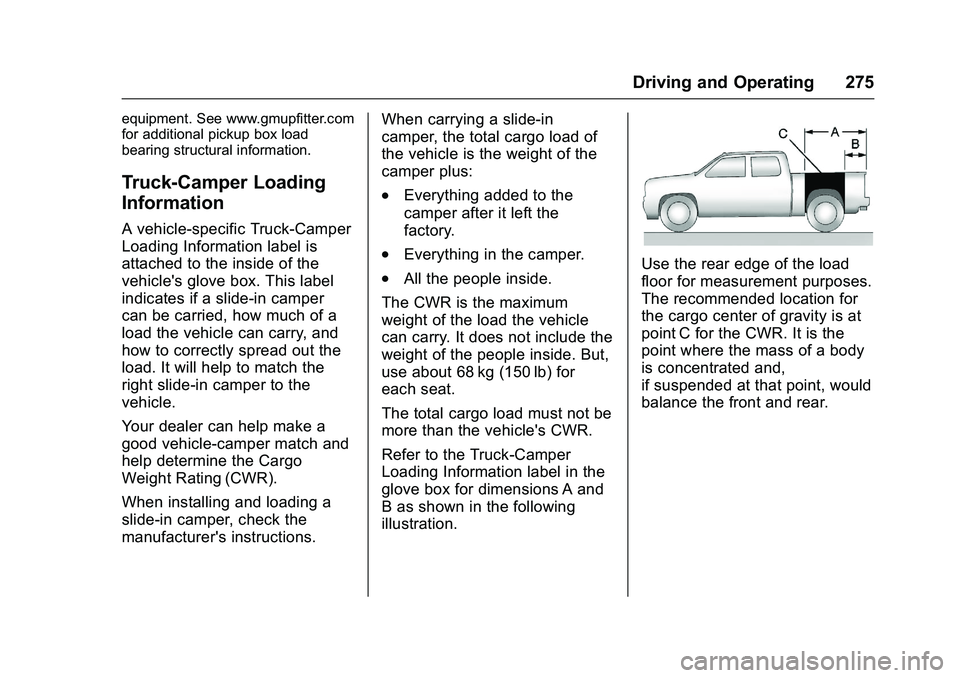
GMC Sierra Owner Manual (GMNA-Localizing-U.S./Canada/Mexico-
9234758) - 2016 - crc - 11/9/15
Driving and Operating 275
equipment. See www.gmupfitter.com
for additional pickup box load
bearing structural information.
Truck-Camper Loading
Information
A vehicle-specific Truck-Camper
Loading Information label is
attached to the inside of the
vehicle's glove box. This label
indicates if a slide-in camper
can be carried, how much of a
load the vehicle can carry, and
how to correctly spread out the
load. It will help to match the
right slide-in camper to the
vehicle.
Your dealer can help make a
good vehicle-camper match and
help determine the Cargo
Weight Rating (CWR).
When installing and loading a
slide-in camper, check the
manufacturer's instructions.When carrying a slide-in
camper, the total cargo load of
the vehicle is the weight of the
camper plus:
.Everything added to the
camper after it left the
factory.
.Everything in the camper.
.All the people inside.
The CWR is the maximum
weight of the load the vehicle
can carry. It does not include the
weight of the people inside. But,
use about 68 kg (150 lb) for
each seat.
The total cargo load must not be
more than the vehicle's CWR.
Refer to the Truck-Camper
Loading Information label in the
glove box for dimensions A and
B as shown in the following
illustration.Use the rear edge of the load
floor for measurement purposes.
The recommended location for
the cargo center of gravity is at
point C for the CWR. It is the
point where the mass of a body
is concentrated and,
if suspended at that point, would
balance the front and rear.
Page 277 of 509
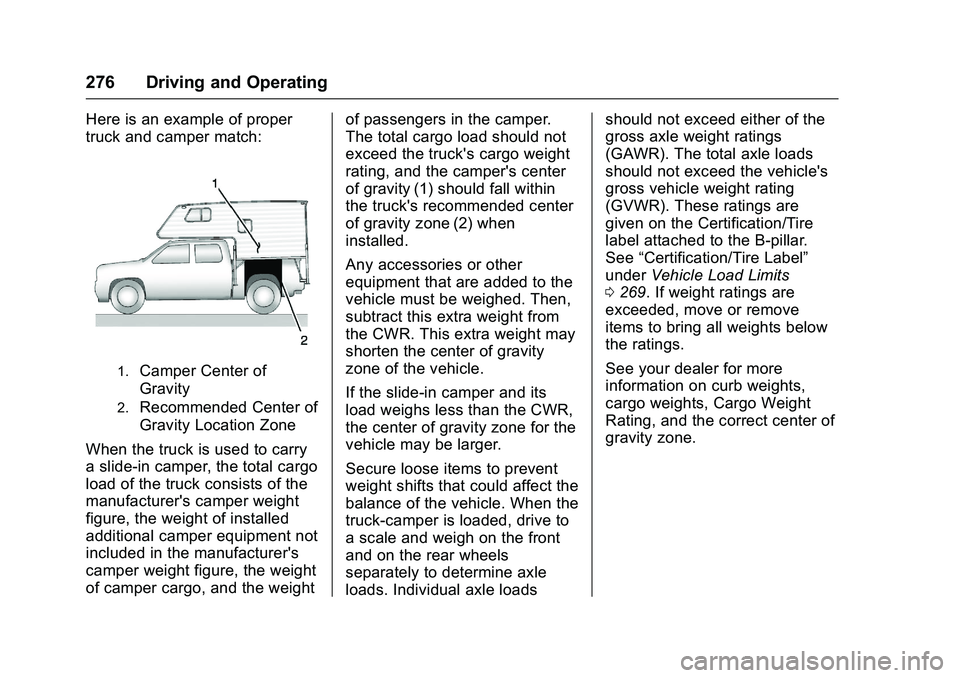
GMC Sierra Owner Manual (GMNA-Localizing-U.S./Canada/Mexico-
9234758) - 2016 - crc - 11/9/15
276 Driving and Operating
Here is an example of proper
truck and camper match:
1.Camper Center of
Gravity
2.Recommended Center of
Gravity Location Zone
When the truck is used to carry
a slide-in camper, the total cargo
load of the truck consists of the
manufacturer's camper weight
figure, the weight of installed
additional camper equipment not
included in the manufacturer's
camper weight figure, the weight
of camper cargo, and the weight of passengers in the camper.
The total cargo load should not
exceed the truck's cargo weight
rating, and the camper's center
of gravity (1) should fall within
the truck's recommended center
of gravity zone (2) when
installed.
Any accessories or other
equipment that are added to the
vehicle must be weighed. Then,
subtract this extra weight from
the CWR. This extra weight may
shorten the center of gravity
zone of the vehicle.
If the slide-in camper and its
load weighs less than the CWR,
the center of gravity zone for the
vehicle may be larger.
Secure loose items to prevent
weight shifts that could affect the
balance of the vehicle. When the
truck-camper is loaded, drive to
a scale and weigh on the front
and on the rear wheels
separately to determine axle
loads. Individual axle loadsshould not exceed either of the
gross axle weight ratings
(GAWR). The total axle loads
should not exceed the vehicle's
gross vehicle weight rating
(GVWR). These ratings are
given on the Certification/Tire
label attached to the B-pillar.
See
“Certification/Tire Label”
under Vehicle Load Limits
0 269. If weight ratings are
exceeded, move or remove
items to bring all weights below
the ratings.
See your dealer for more
information on curb weights,
cargo weights, Cargo Weight
Rating, and the correct center of
gravity zone.
Page 285 of 509
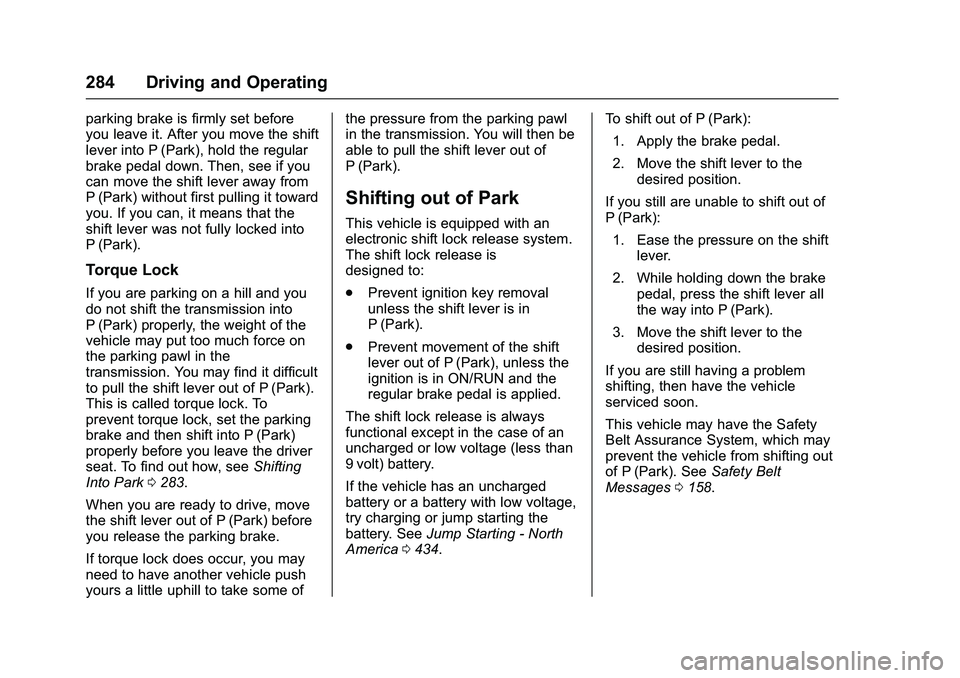
GMC Sierra Owner Manual (GMNA-Localizing-U.S./Canada/Mexico-
9234758) - 2016 - crc - 11/9/15
284 Driving and Operating
parking brake is firmly set before
you leave it. After you move the shift
lever into P (Park), hold the regular
brake pedal down. Then, see if you
can move the shift lever away from
P (Park) without first pulling it toward
you. If you can, it means that the
shift lever was not fully locked into
P (Park).
Torque Lock
If you are parking on a hill and you
do not shift the transmission into
P (Park) properly, the weight of the
vehicle may put too much force on
the parking pawl in the
transmission. You may find it difficult
to pull the shift lever out of P (Park).
This is called torque lock. To
prevent torque lock, set the parking
brake and then shift into P (Park)
properly before you leave the driver
seat. To find out how, seeShifting
Into Park 0283.
When you are ready to drive, move
the shift lever out of P (Park) before
you release the parking brake.
If torque lock does occur, you may
need to have another vehicle push
yours a little uphill to take some of the pressure from the parking pawl
in the transmission. You will then be
able to pull the shift lever out of
P (Park).
Shifting out of Park
This vehicle is equipped with an
electronic shift lock release system.
The shift lock release is
designed to:
.
Prevent ignition key removal
unless the shift lever is in
P (Park).
. Prevent movement of the shift
lever out of P (Park), unless the
ignition is in ON/RUN and the
regular brake pedal is applied.
The shift lock release is always
functional except in the case of an
uncharged or low voltage (less than
9 volt) battery.
If the vehicle has an uncharged
battery or a battery with low voltage,
try charging or jump starting the
battery. See Jump Starting - North
America 0434. To shift out of P (Park):
1. Apply the brake pedal.
2. Move the shift lever to the desired position.
If you still are unable to shift out of
P (Park): 1. Ease the pressure on the shift lever.
2. While holding down the brake pedal, press the shift lever all
the way into P (Park).
3. Move the shift lever to the desired position.
If you are still having a problem
shifting, then have the vehicle
serviced soon.
This vehicle may have the Safety
Belt Assurance System, which may
prevent the vehicle from shifting out
of P (Park). See Safety Belt
Messages 0158.
Page 327 of 509

GMC Sierra Owner Manual (GMNA-Localizing-U.S./Canada/Mexico-
9234758) - 2016 - crc - 11/9/15
326 Driving and Operating
Caution (Continued)
vehicle warranty. To pull a trailer
correctly, follow the advice in this
section and see your dealer for
important information about
towing a trailer with the vehicle.
See Vehicle Load Limits 0269 for
more information about the vehicle's
maximum load capacity.
To identify the trailering capacity of
the vehicle, read the information in
“Weight of the Trailer” later in this
section.
Trailering is different than just
driving the vehicle by itself.
Trailering means changes in
handling, acceleration, braking,
durability, and fuel economy.
Successful, safe trailering takes
correct equipment, and it has to be
used properly.
The following information has many
time-tested, important trailering tips
and safety rules. Many of these are important for your safety and that of
your passengers. Read this section
carefully before pulling a trailer.
Weight of the Trailer
Safe trailering requires monitoring
the weight, speed, altitude, road
grades, outside temperature, and
how frequently the vehicle is used to
pull a trailer. Take into consideration
any special equipment on the
vehicle, and the amount of tongue
weight the vehicle can carry. See
“Weight of the Trailer Tongue”
later
in this section for more information.
Trailer weight rating (TWR) for
pickup models is calculated
assuming the tow vehicle has the
driver, a front seat passenger, and
all required trailering equipment.
Weight of additional optional
equipment, passengers, and cargo
in the tow vehicle must be
subtracted from the trailer weight
rating.
Ask your dealer for trailering
information or advice. For kingpin weight and trailer
tongue weight information, see
“Weight of the Trailer Tongue”
later
in this section.
Use the following chart to determine
how much the vehicle can weigh,
based upon the vehicle model and
options.
Weights listed apply for
conventional trailers and fifth-wheel
trailers unless otherwise noted.
Page 328 of 509
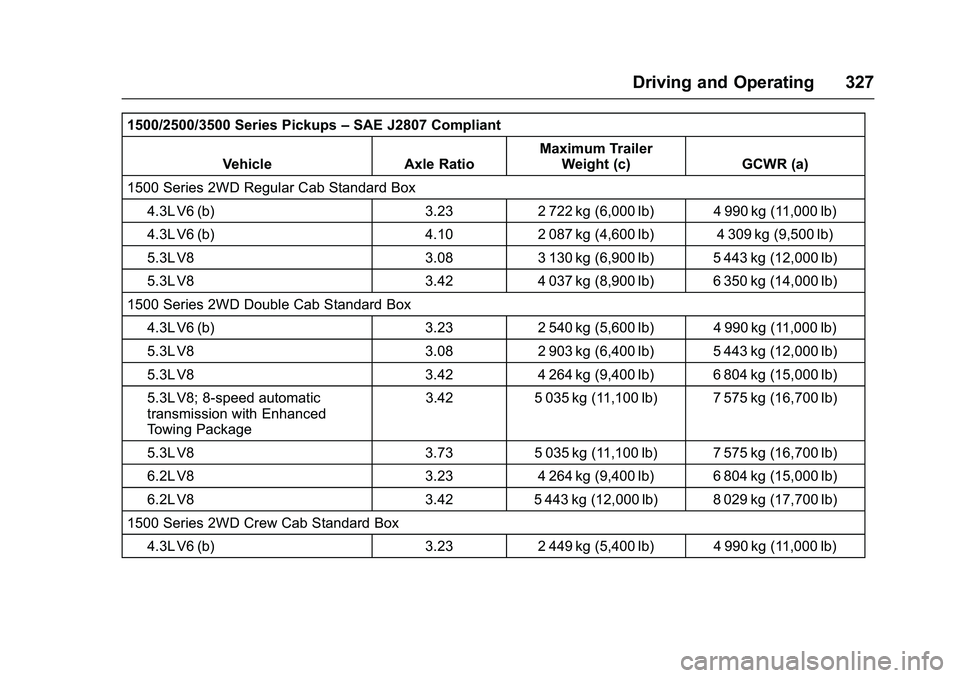
GMC Sierra Owner Manual (GMNA-Localizing-U.S./Canada/Mexico-
9234758) - 2016 - crc - 11/9/15
Driving and Operating 327
1500/2500/3500 Series Pickups–SAE J2807 Compliant
Vehicle Axle Ratio Maximum Trailer
Weight (c) GCWR (a)
1500 Series 2WD Regular Cab Standard Box 4.3L V6 (b) 3.23 2 722 kg (6,000 lb) 4 990 kg (11,000 lb)
4.3L V6 (b) 4.10 2 087 kg (4,600 lb) 4 309 kg (9,500 lb)
5.3L V8 3.08 3 130 kg (6,900 lb) 5 443 kg (12,000 lb)
5.3L V8 3.42 4 037 kg (8,900 lb) 6 350 kg (14,000 lb)
1500 Series 2WD Double Cab Standard Box 4.3L V6 (b) 3.23 2 540 kg (5,600 lb) 4 990 kg (11,000 lb)
5.3L V8 3.08 2 903 kg (6,400 lb) 5 443 kg (12,000 lb)
5.3L V8 3.42 4 264 kg (9,400 lb) 6 804 kg (15,000 lb)
5.3L V8; 8-speed automatic
transmission with Enhanced
Towing Package 3.42 5 035 kg (11,100 lb) 7 575 kg (16,700 lb)
5.3L V8 3.73 5 035 kg (11,100 lb) 7 575 kg (16,700 lb)
6.2L V8 3.23 4 264 kg (9,400 lb) 6 804 kg (15,000 lb)
6.2L V8 3.42 5 443 kg (12,000 lb) 8 029 kg (17,700 lb)
1500 Series 2WD Crew Cab Standard Box 4.3L V6 (b) 3.23 2 449 kg (5,400 lb) 4 990 kg (11,000 lb)
Page 329 of 509
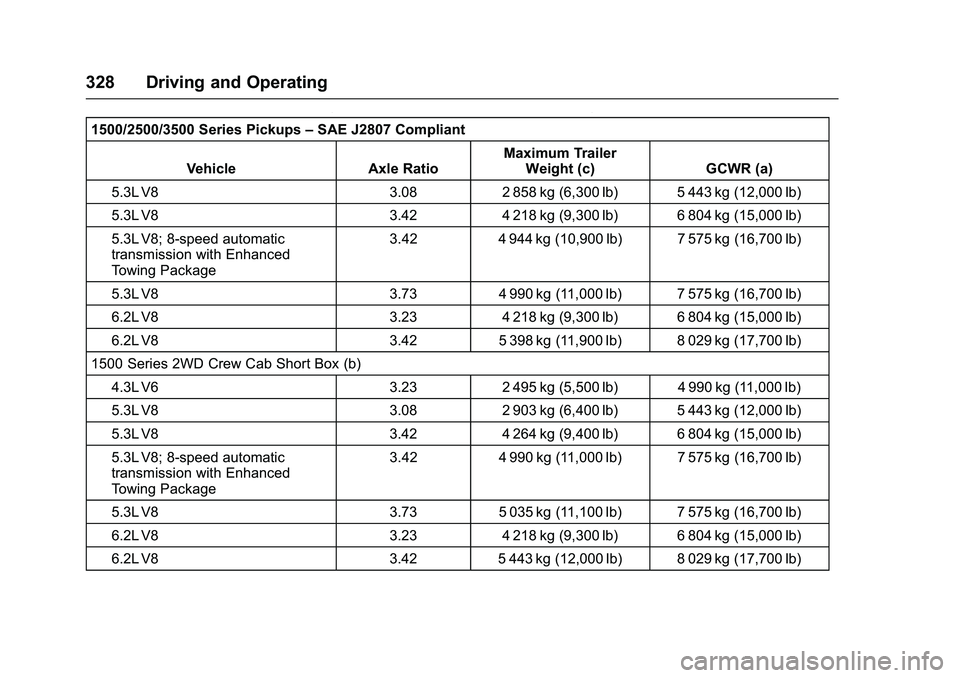
GMC Sierra Owner Manual (GMNA-Localizing-U.S./Canada/Mexico-
9234758) - 2016 - crc - 11/9/15
328 Driving and Operating
1500/2500/3500 Series Pickups–SAE J2807 Compliant
Vehicle Axle Ratio Maximum Trailer
Weight (c) GCWR (a)
5.3L V8 3.08 2 858 kg (6,300 lb) 5 443 kg (12,000 lb)
5.3L V8 3.42 4 218 kg (9,300 lb) 6 804 kg (15,000 lb)
5.3L V8; 8-speed automatic
transmission with Enhanced
Towing Package 3.42 4 944 kg (10,900 lb) 7 575 kg (16,700 lb)
5.3L V8 3.73 4 990 kg (11,000 lb) 7 575 kg (16,700 lb)
6.2L V8 3.23 4 218 kg (9,300 lb) 6 804 kg (15,000 lb)
6.2L V8 3.42 5 398 kg (11,900 lb) 8 029 kg (17,700 lb)
1500 Series 2WD Crew Cab Short Box (b) 4.3L V6 3.23 2 495 kg (5,500 lb) 4 990 kg (11,000 lb)
5.3L V8 3.08 2 903 kg (6,400 lb) 5 443 kg (12,000 lb)
5.3L V8 3.42 4 264 kg (9,400 lb) 6 804 kg (15,000 lb)
5.3L V8; 8-speed automatic
transmission with Enhanced
Towing Package 3.42 4 990 kg (11,000 lb) 7 575 kg (16,700 lb)
5.3L V8 3.73 5 035 kg (11,100 lb) 7 575 kg (16,700 lb)
6.2L V8 3.23 4 218 kg (9,300 lb) 6 804 kg (15,000 lb)
6.2L V8 3.42 5 443 kg (12,000 lb) 8 029 kg (17,700 lb)
Page 330 of 509
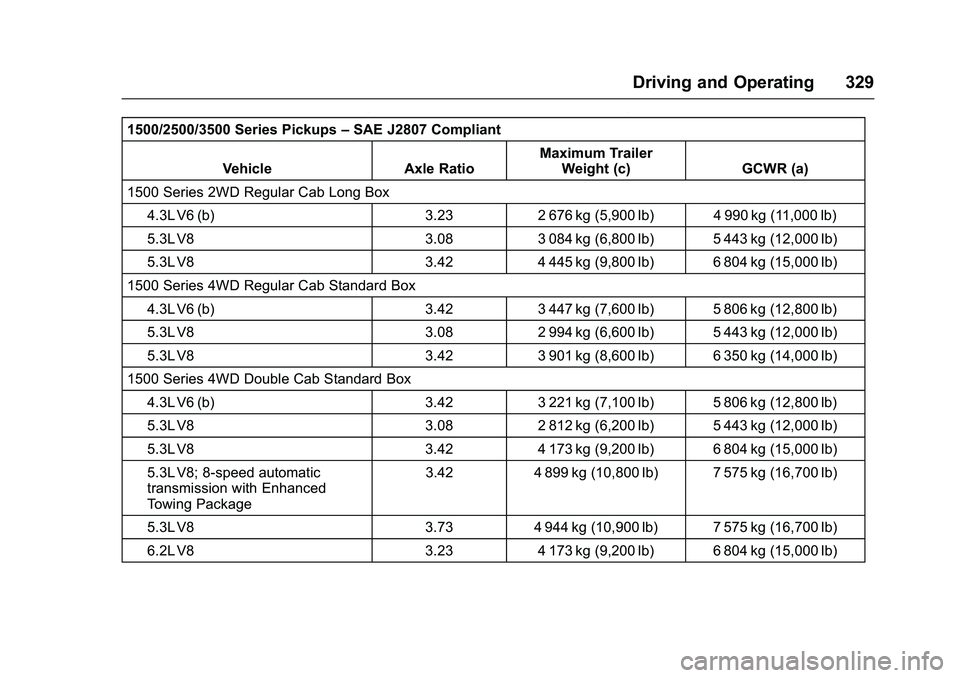
GMC Sierra Owner Manual (GMNA-Localizing-U.S./Canada/Mexico-
9234758) - 2016 - crc - 11/9/15
Driving and Operating 329
1500/2500/3500 Series Pickups–SAE J2807 Compliant
Vehicle Axle Ratio Maximum Trailer
Weight (c) GCWR (a)
1500 Series 2WD Regular Cab Long Box 4.3L V6 (b) 3.23 2 676 kg (5,900 lb) 4 990 kg (11,000 lb)
5.3L V8 3.08 3 084 kg (6,800 lb) 5 443 kg (12,000 lb)
5.3L V8 3.42 4 445 kg (9,800 lb) 6 804 kg (15,000 lb)
1500 Series 4WD Regular Cab Standard Box 4.3L V6 (b) 3.42 3 447 kg (7,600 lb) 5 806 kg (12,800 lb)
5.3L V8 3.08 2 994 kg (6,600 lb) 5 443 kg (12,000 lb)
5.3L V8 3.42 3 901 kg (8,600 lb) 6 350 kg (14,000 lb)
1500 Series 4WD Double Cab Standard Box 4.3L V6 (b) 3.42 3 221 kg (7,100 lb) 5 806 kg (12,800 lb)
5.3L V8 3.08 2 812 kg (6,200 lb) 5 443 kg (12,000 lb)
5.3L V8 3.42 4 173 kg (9,200 lb) 6 804 kg (15,000 lb)
5.3L V8; 8-speed automatic
transmission with Enhanced
Towing Package 3.42 4 899 kg (10,800 lb) 7 575 kg (16,700 lb)
5.3L V8 3.73 4 944 kg (10,900 lb) 7 575 kg (16,700 lb)
6.2L V8 3.23 4 173 kg (9,200 lb) 6 804 kg (15,000 lb)
Page 331 of 509
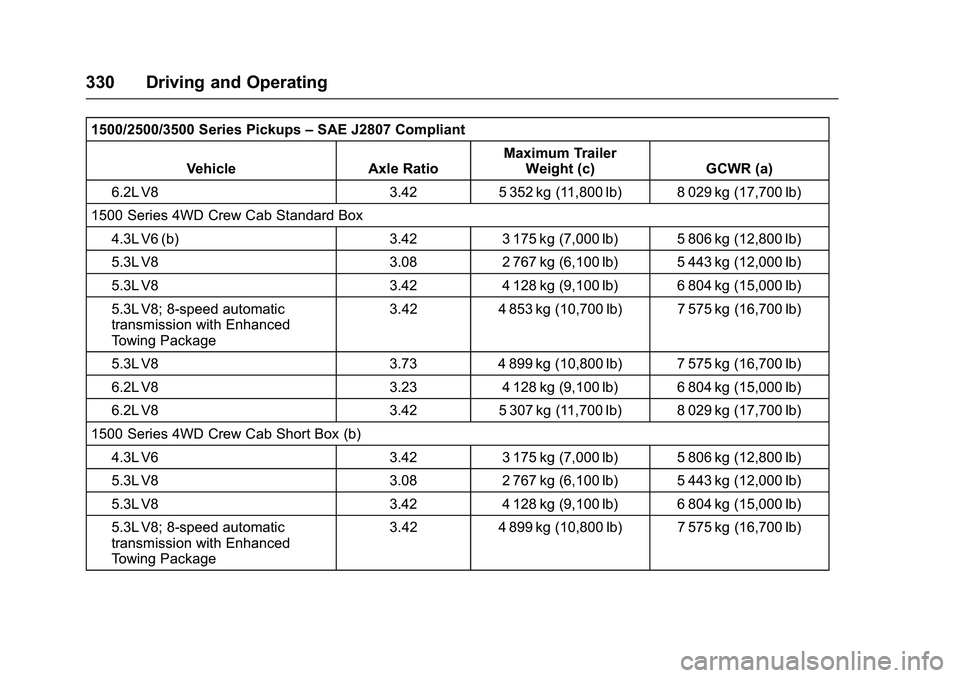
GMC Sierra Owner Manual (GMNA-Localizing-U.S./Canada/Mexico-
9234758) - 2016 - crc - 11/9/15
330 Driving and Operating
1500/2500/3500 Series Pickups–SAE J2807 Compliant
Vehicle Axle Ratio Maximum Trailer
Weight (c) GCWR (a)
6.2L V8 3.42 5 352 kg (11,800 lb) 8 029 kg (17,700 lb)
1500 Series 4WD Crew Cab Standard Box 4.3L V6 (b) 3.42 3 175 kg (7,000 lb) 5 806 kg (12,800 lb)
5.3L V8 3.08 2 767 kg (6,100 lb) 5 443 kg (12,000 lb)
5.3L V8 3.42 4 128 kg (9,100 lb) 6 804 kg (15,000 lb)
5.3L V8; 8-speed automatic
transmission with Enhanced
Towing Package 3.42 4 853 kg (10,700 lb) 7 575 kg (16,700 lb)
5.3L V8 3.73 4 899 kg (10,800 lb) 7 575 kg (16,700 lb)
6.2L V8 3.23 4 128 kg (9,100 lb) 6 804 kg (15,000 lb)
6.2L V8 3.42 5 307 kg (11,700 lb) 8 029 kg (17,700 lb)
1500 Series 4WD Crew Cab Short Box (b) 4.3L V6 3.42 3 175 kg (7,000 lb) 5 806 kg (12,800 lb)
5.3L V8 3.08 2 767 kg (6,100 lb) 5 443 kg (12,000 lb)
5.3L V8 3.42 4 128 kg (9,100 lb) 6 804 kg (15,000 lb)
5.3L V8; 8-speed automatic
transmission with Enhanced
Towing Package 3.42 4 899 kg (10,800 lb) 7 575 kg (16,700 lb)